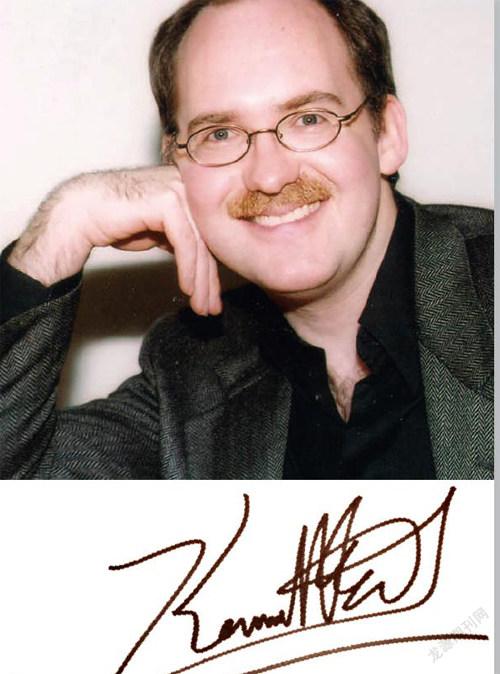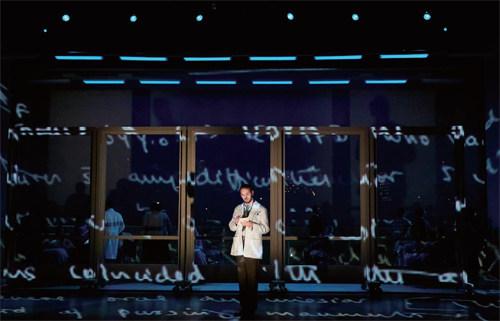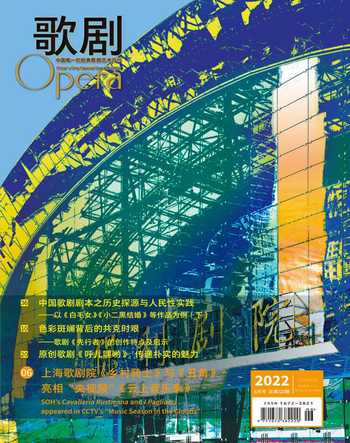基于事实:把真人真事搬上舞台
司马勤



我仍在思考几周前的一个念头:每当一个故事在不同的媒介中获得新生时,我们都应该去关注新版本究竟如何使原著变得更为丰富。越是伟大的小说,改编工作越是艰巨,因为原著本身已经构建出一个完整的世界。比较稳妥的方案是选择相对来说不算伟大或经典的作品——最好是那些角色刻画深刻、极具戏剧张力的——为音乐与视觉效果留有足够空间以丰富故事情节。以此类推,梅里美(Mérimée)笔下的卡门在任何情况下,要比福楼拜的包法利夫人更胜一筹。
了解改编作品,我们需要熟知“源材料”(sourcematerial)吗?今天大家提起费加罗的时候,大多联想到的是莫扎特和罗西尼歌剧中的那位经典主角,尽管我们可以肯定当年的观众都应该认识剧作家博马舍(Beaumarchais)。让我在这里记录在案,歌剧的艺术范畴里很少会出现“剧透”之类的东西。自从奥菲欧首次潜入冥界试图营救优丽狄茜,我们都能推测出往后的情节发展。如何把故事叙述出来才是重点。
那么,当舞台上描述的故事是真有其事、真有其人,或者至少是接近真实历史的,又会发生什么呢?当观众们还记得当年新闻里头版头条的“源材料”,那么主创们应该对这些材料负有多少责任?为了艺术,对真实材料的加工和改造的自由度能有多大?最近在圣路易斯,我有机会从现实案例中探讨这些疑问。
事实上,我并不是刻意去关注这个问题的。圣路易斯歌剧院本年度正忙于重回正常运营轨道。自2019 年至去年,歌剧院无法在自家常驻地罗勒托-希尔顿中心(Loretto-Hilton Center) 的舞台上演出。但尽管如此,剧院终于在今年6 月拉开帷幕的2022 年歌剧节中,献上了一部世界首演作品(原定于2020 年上演)与一部当代歌剧重演(原定于2021 年上演)。这两部歌剧均基于真人真事。
我应该补充一下,对于圣路易斯歌剧院来说,这类题材并不算特别,近几年的舞台上都有过先例:2018 年,黄若与黄哲伦合作的《一个美国士兵》(An American Soldier ),描述了华裔美国士兵陈宇晖经历种族主义欺凌后自杀的惨剧;2019 年,特伦斯· 布兰查德(Terence Blanchard)与卡西· 莱蒙斯(Kasi Lemmons)创作了《骨子里的烈火》(FireShut Up in My Bones ,后来被纽约大都会歌剧院选中为2021–2022 演出季的开幕剧目)。《烈火》改编自《纽约时报》专栏作家查尔斯· 布洛(CharlesBlow)的同名畅销回忆录,而《士兵》则取材自报刊头条,再加上一些一手资料。
今年圣路易斯歌剧院“源于真实”的两部歌剧的演出,安排得十分靠近。本来应该在2020 年首演的是托拜厄斯· 皮克(Tobias Picker)的《觉醒》(Awakenings )。歌剧改编自1972 年出版的同名书籍,正是已故奥利弗· 萨克斯医生(Dr. OliverSacks)身为作家的成名作。虽然说引用病例个案作为歌剧“源材料”有些不可思议,但是萨克斯笔下描述的为患上乙型脑炎(encephalitis lethargica ,又称“ 睡眠病症”) 的病人尝试使用左旋多巴(L-DOPA)进行治疗的经历,在舞台上多次出现,并于1990 年翻拍成好萊坞电影,到了2010 年又改编成芭蕾舞剧(作曲家正是皮克)。这部歌剧的编剧是阿里赫· 列夫· 斯托曼(Aryeh Lev Stollman,他是神经科医生,也是皮克的生活伴侣),与作曲家一道,让故事中的各人有机会把心底话诉说出来,与萨克斯医生的原著有着异曲同工之妙。
从这部歌剧制作整体来看,演出顺畅流利。导演詹姆斯· 罗宾逊(James Robinson) 的视觉观感与音乐动力相辅相成,尽管阿伦· 莫耶(AllenMoyer)简约与模块化的布景变换频繁,比剧中人的动作还要多得多。皮克与斯托曼明智地把萨克斯原著中的不同个案浓缩从简,舞台上的主要病人只有三位:罗斯(Rose)虽然醒来,却只活在过去的甜蜜回忆中;米利亚姆(Miriam H.)与女儿跟孙女重逢,她们本来被告知她早已逝世;里昂纳德· 列夫(Leonard Lev,也是思考力最强的病人)虽然已是成年人,突然间要面对迟来的青春期冲动,并需要与他年迈的母亲重新界定彼此的关系。
但是, 若我们要衡量这部乐剧(musicaldrama),《觉醒》令人困惑。“作品中没有‘故事成分,”中场休息时,这个评语在我耳边多次浮现(后来的报刊剧评中也出现了同样的评价)。可是,这种批评不完全正确,你只需要看看哈罗德· 品特(Harold Pinter)的话剧或潘妮· 马歇尔(PennyMarshall)导演的电影就会发现,《觉醒》内藏精彩的故事。问题是,倘若帕斯卡(Pascal)活在现代世界,他可能会质问,选择“哪一个”故事来表现?皮克患有妥瑞症候群(Touretts syndrome),曾是萨克斯医生的病人,斯托曼也是萨克斯的朋友与专业同行。有时候,我搞不清楚主创两人的关注点是聚焦于病人还是医生本身。
诚然,身为医生与作家,萨克斯成功地掌控了这种平衡:既将病人的个性与特征描述得非常全面(这一点显然在1970 年的医学行业相当罕见),又将他在治疗过程从中领会到的、对于自己个人与专业进展的细节进行了分享。在歌剧中饰演萨克斯医生的男中音贾勒特· 波特(Jarrett Porter)捕捉到了这位医师笔下令人佩服的洞察力与同情心。
跟他的大部分作品一样,皮克的音乐大致上具有调性,亦易于演唱,但是《觉醒》仍然遇上一些问题。“假如我要写歌剧,”中场休息灯亮起不久,坐在我后排的男士跟他的同伴抱怨道,“不要让我为一堆医学术语或拉丁名词谱上音乐。”在第一幕中,合唱团要唱出以下的歌词:Anticholinergics! Belladonna!Apomorphine! Amphetamines! Antimuscarinics!Trihexyphenidyl!( 抗胆碱药!颠茄制剂!阿朴吗啡!抗蕈毒碱类药物!苯海索!)多么绕口啊!的确如此。
斯托曼的歌词处理证明了他精通医学术语,但他忽略了萨克斯自身的故事是随着时间的推移而改变的。当年,医生认为整个实验失败之极。而过了十年之后,无论医生还是病人,回顾那段光景,他们的结论是成败参半。在1982 年修订版的《觉醒》一书的尾声中,萨克斯详述了当年的一个场景,在纪录片以及马歇尔版的电影中都出现过:“我一直都感到欣慰,一动都不动的睡眠症病人可以精准无误地抛球接球,而每个人的动作都有属于自己的独特风格。”那为什么皮克笔下的每位病人在歌唱时,我们听到的音乐风格基本上没有区别?
众所周知,这些年来,要是改编者试图挖出更深层的真理,去刻意调整某些事实,萨克斯医生都宽容地接纳了那些改动。但是,我怀疑若他今天仍在世的话,他会怎样看待歌剧中强调的三角恋。病人里昂纳德暗恋男护士,但男护士却喜欢萨克斯医生;医生尽管喜欢男护士,却没有勇气面对这种情况。到了歌剧接近尾声,有一小段倒叙了医生的母亲因为儿子是同性恋而嫌弃了他。前者显得不必要并与事实背道而驰(里昂纳德当年令很多女护士束手无措;还有,在1970 年代,男护士十分稀有),后者又无缘无故地插进这部歌剧中,却几乎没有叙事或者因果的作用。萨克斯是一位害羞内敛的人,到他2015 年去世前一个月出版的著作中,他才透露了他的性取向。从这一点来看,歌剧的这两处加工,疑似滥用了萨克斯对作品改编的信任。
出现在这个夏季舞台的复排剧目,当代歌剧《哈维· 米尔克》(Harvey Milk )则情况完全不同。歌剧于1995 年在休斯敦举行世界首演,作曲家斯图尔特· 华莱士(Stewart Wallace,中文名惠士钊)与编剧迈克尔· 科里(Michael Korie)把20 世纪70 年代末一位著名的同性恋市议员与他被刺杀的过程呈现在舞台上,表面桀骜不驯,实则杂乱无章。作品首演大约18 个月后,再次在旧金山歌剧院亮相(旧金山歌剧院是作品的联合委约方之一),尽管主创二人做了大量修改,但是其中华丽的政治场面经常掩盖了作品的戏剧性。
在圣路易斯歌剧院搬演的新版本(上演计划从2021 年延迟至2022 年)则更为精简。本来时长3 小时的曲折三幕剧“瘦身”至2 小时时长的两幕戏,众多次要角色都被删减了。米尔克与他的敌人丹尼· 怀特(Dan White)不再是不同政治平台上的象征,而是有血有肉的人物。虽然男中音托马斯· 格拉斯(Thomas Glass)与男高音凯撒· 安德里斯· 帕瑞诺(César Andrés Parre?o)的长相与真实人物有很大差异(舞台上投映了当年的历史照片,因此大家都看得清清楚楚),演技与感情的抒发却令人信服。
那么故事的其他部分又如何呢?有一点我觉得特别有趣。此前我刚刚离开旧金山,美国航空与捷蓝航空(JetBlue)所用的专属航站楼取名为“哈维·米尔克1 号航站楼”;再往前一天,我约了朋友吃午饭,餐厅与旧金山公立图书馆哈维· 米尔克分馆只有一街之隔。米尔克先生虽然英年早逝,但他在旧金山的痕迹无处不在。
我在飞机上阅读了《卡斯特罗街的市长》(TheMayor of Castro Street),兰迪· 席尔兹(Randy Shilts)详细研究米尔克事件后发表的报道文学。他描述了米尔克的一生,包括当年快速晋升之路,直至他遇刺的经过。跟《觉醒》一样,这个故事被拍成了纪录片以及好莱坞故事片。这些影片与《觉醒》也有雷同:细节经常背离原作,被压缩或者删减。
这两部歌剧也具有相似的叙事特征,最显著的是采用了电影化倒叙的手法,让观众了解主角少年成长的点滴。(米尔克跟他的母亲同样有着复杂的关系,他的母亲告诫他要“留心那些与众不同的男人”。)视觉上,这两部歌剧像是兄弟篇,因为导演罗宾逊聘用了同一个设计团队,他们的舞台手法也相当雷同:莫耶建造了模块化布景,埃莫塔斯(Emetaz)则是在后幕投影报章头条。
但是打从音乐响起的第一拍开始,《哈维·米尔克》给观众呈现的是截然不同的音乐体验。与黄哲伦根据陈宇晖一生撰写的《一个美国士兵》的手法一样,克里挖掘了很多一手资料,想办法让报章上已刊登的细节连贯起来,故事因而更加丰富——那些细节一直以来都存在着。幸好,从前那颗硕大的、未经雕磨的原石,现在被打磨成一颗精细的、轮廓分明的宝石,唱词以及音乐的旋律线条因而更具冲击力。
克里才华横溢,他的笔下精准地捕捉到周边环境、人物个性与思想,令观众感到强烈共鸣。华莱士的音乐恰到好处,唱词中描述的世界也通过不同风格的乐段呈现出来——突显米尔克身份的犹太教颂歌,以及当年的流行音乐与氛围——并且点到即止,从不拖泥带水。米尔克是个超级歌剧迷,所以乐队也奏响了一句半句瓦格纳与普契尼(米尔克遇刺前一晚正是在旧金山歌剧院观看《托斯卡》)。作品的戏剧即时性有赖于众多演员的努力,但是音乐成功的最关键人物是指挥关琦安(Carolyn Kuan)。她灵巧地带领圣路易斯交响乐团演绎华莱士“瘦身”后的配器,每一个重要情节除了精确以外,还有机会优雅地延伸至下一个段落,无可挑剔。
且不说早些年这部作品的那些瑕疵,《哈维· 米尔克》于1995 年首演时是为了庆祝一个重要里程碑。尤其在旧金山,这部歌剧彰显的是那个年代,同性恋、黑人与亚裔一起合作,为争取民权的奋斗经历。《哈维· 米尔克》在圣路易斯的最后一場演出正好碰上了市内举办的2022 年同性恋自豪庆祝活动(Pride celebrations),让我们再次反思了美国国家的现状。我猜,创作团队一定没有想到,多年后的今天,这些主题仍然恰逢其时。
这部歌剧中的不少主题到了今天还会出现在美国新闻的每日头条中——警察暴力、压制少数族群的暴力、独行枪手滥杀无辜甚至大屠杀——我发觉自己就像《觉醒》里面那些“睡公主”与华盛顿·欧文笔下的“瑞普· 凡· 温克尔”(Rip Van Winkles),在沉睡半个世纪后醒来,却发现周边的一切没有什么改变。
Im still pondering a thought from a few weeksago: Each time a story takes on new life in a differentmedium, we should ask what the new version adds.Great novels are the hardest to adapt because theycreate a world complete in itself. Better to stick withlesser works—preferably those with memorablecharacters in highly dramatic situations—where thestory leaves plenty of room for music and visuals. Bythat count, Mérimées Carmen trumps Flauberts EmmaBovary any day.
How well do we need to know that source material?When people think of Figaro today its Mozart andRossini who come to mind, though we can be fairlycertain audiences in their day knew Beaumarchais. Andfor the record, theres rarely such a thing as “spoilers”in opera. Ever since Orfeo first entered the Underworldto rescue Eurydice, we pretty much know how the storyturns out. The point is in the telling.
What happens, though, when the stories on stageare true, or at least true-ish? How much responsibilitydo the creators owe the source material, or theoriginal facts, when audiences can still remember theheadlines? How far can you bend truth in service to art?I was fortunate enough to encounter a living workshopon these points recently in St. Louis.
Not that it was intentional. The Opera Theatre ofSt. Louis was too busy just getting itself back in gear,having been away from its home at the Loretto-HiltonCenter since 2019. But nonetheless, the companys 2022festival season in June included one world premiereand a significant contemporary revival, both based ontrue stories.
I should add that this is not particularly unusual forOTSL. Two other examples that come to mind are HuangRuo and David Henry Hwangs An American Soldier from2018 recounting the story of Danny Chen, a ChineseAmerican US Army Soldier whose racial harassmentin the military led to his eventual suicide, and TerenceBlanchard and Kasi Lemmons Fire Shut Up in My Bonesfrom 2019 (which later opened the Metropolitan Operas2021–2022 season). Fire was adapted from a bestsellingmemoir by New York Times columnist Charles Blow.Soldier was ripped from the headlines, embellishedwith some additional first-hand reporting.
This year, though, OTSL presented its two “true”operas in close proximity. The festivals world premiere(postponed from 2020) was Tobias Pickers Awakenings ,based on the 1972 book that essentially launched Dr.Oliver Sacks literary career. A collection of medical casestudies may seem unlikely source material, but Sacksaccount of treating patients suffering from encephalitislethargica (“sleeping sickness”) with the experimentaldrug L-DOPA had already inspired a number of stageadaptations, a 1990 Hollywood film and a 2010 ballet(also by Picker). Now armed with a libretto by Aryeh LevStollman (a neurologist as well as Pickets life partner),the composer brought the characters to verbal life,much as Dr. Sacks did in his original account.
As a production, the show perked along smoothly.Director James Robinson matched the musicsmomentum visually, even if Allen Moyers minimal,modular sets often moved more than the characters.Picker and Stollman wisely condensed Sacks caseloadto three patients: Rose, who awakens in the presentbut continues to live sweetly in the past; Miriam H.,who reunites with her daughter and granddaughter,both of whom had been told she was dead; andLeonard Lev (Sacks most reflective patient), who as anadult belatedly confronts his adolescent urges whilerenegotiating his relationship with his aging mother.
As a piece of musical drama, however, the work wastroubled. “Theres no ‘story in this stuff,” I heard severaltimes during intermission (and read in a couple ofreviews afterwards). That wasnt exactly true, as HaroldPinters play and Penny Marshalls film can attest. Theproblem is, as Pascal might ask in a modern world,which story? Picker, who has Touretts syndrome, was apatient of the late Dr. Sacks; Stollman was a friend andprofessional colleague. At times, it was often unclearwhether the two creators were focused on the patientsor the doctor himself.
Sacks, of course, managed that balance, both relatingto his patients as fully realized personalities (apparentlyquite uncommon in the medical profession in the 1970s)and sharing his own personal and professional growththrough what he learned from them. (In performance,baritone Jarrett Porter brought to his portrayal of Sacksmuch of the doctors fabled insight and compassion.)
As in most of his output, Picker writes music thatis largely tonal and eminently singable, thoughAwakenings nonetheless runs into problems. “If Iever write an opera,” the man behind me grumbledto his companion when the lights came up, “dontlet me set a bunch of diseases to music, or use anyLatin terminology.” At one point, the full ensemblesings “Anticholinergics! Belladonna! Apomorphine!Amphetamines! Antimuscarinics! Trihexyphenidyl!What a mouthful!” Indeed.
Stollman proves proficient in wielding medicalterms, but he ignores entirely the fact that Sacksown story changed over time. What the doctorinitially considered a failed experiment he (andhis patients) determined was a mixed success adecade later. In his epilogue to the 1982 edition,Sacks recounts a scene that was also capturedmemorably both in the documentary and PennyMarshalls Hollywood film: “I never cease todelight in…how patients unable to initiate asingle movement can catch and return a ball,with perfect accuracy, and wholly in their ownstyle.” So why, I wonder, did all of Pickers patientssound essentially the same.
Sacks was famously tolerant of adaptations thatbent the facts of his findings in search of deeper truths,but one wonders how he would react to the operaslove triangle, where the patient Leonard has longingsfor a male nurse, who has longings for Dr. Sacks, whois tempted but unable to handle the situation. Or aflashback near the end where Sacks recalls beingrejected by his mother over his sexuality. None of this, Ishould add, is in Sacks account. The former seemed anunnecessary departure (It was the female nurses whohad problems with Leonard, and there were few malenurses in the 1970s in any case), the latter gratuitouslygrafted to the story with little narrative cause oroutcome. Considering that Sacks was a famously shyman who only revealed his sexual orientation in a bookpublished a month before his death in 2015, the operaultimately seems like an abuse of trust.
This summers revival, Harvey Milk , was a differentsituation entirely. At its 1995 premiere in Houston,Stewart Wallace and Michael Kories operatic enactmentof the late-1970s gay San Francisco lawmaker and hismurder by a fellow legislator was a rambunctious mess.Some 18 months later, when the production reachedSan Francisco Opera (its co-commissioner), Wallaceand Korie had made many revisions, though politicalpageantry still often obscured the drama.
The new version premiered by Opera Theatre of St.Louis (rescheduled from 2021) was reduced further still,the original meandering three-act, three-hour spectaclenow a sleek two-act, two-hour theatre piece, withmany minor roles cut completely. Milk and his nemesisDan White were no longer merely incarnated politicalplatforms but fully fleshed-out roles. Though baritoneThomas Glass and tenor César Andrés Parre?o lookednothing like their respective characters (as projectionsof historic photos clearly revealed), their performanceswere emotionally compelling and convincing.
But what about the rest of the story? Funnily enough,I had just left San Francisco, where Jet Blue andAmerican Airlines fly out of Harvey Milk Terminal 1. Theday before, I met a friend for lunch a block away fromthe Harvey Milk Branch of the San Francisco PublicLibrary. Mr. Milks untimely death hardly diminished hispresence in the city.
On the plane I was reading The Mayor of CastroStreet , Randy Shilts solidly reported account of Milkslife and death before his fast track to martyrdom. LikeAwakenings , the story became both a documentary anda feature film. Also like Awakenings , those cinematicversions often departed from the text, usually indeleting or compressing details.
The two operas shared many narrative traits as well,not least a quasi-cinematic use of flashbacks chartingthe development of their respective protagonists. (Milk,too, has a complicated relationship with his mother,who warns her son to “watch out for men who aredifferent.”) Visually, the shows were practically siblings,with director Robinson using the same design teamand similar visual approach, from Moyers modular setpieces to Emetazs projected newspaper headlines.
But right from the downbeat, Harvey Milk was acompletely different musical experience. Much asHwang did with Danny Chens story in An AmericanSoldier , Korie had engaged in much first-handreporting, providing him with the narrative hooks tohang previously reported details. Those details hadalways been on display, but the raw, oversized stonewas now a finely chiselled gem, with verbal and musicallines gleaming with greater impact.
Kories gift is in spinning the precise line that capturesa setting, a personality, an idea, and continues toresonate. Wallaces gift is in finding the right musicto evoke the world behind that line—a Kaddishhighlighting Milks Jewish heritage, echoes of pop musicto evoke both the historic period and its sensibility—andmoving on before it wears out its welcome. Snippets ofWagner and Puccini underscored Milk as huge opera fan(he had, in fact, seen Tosca at the San Francisco Operathe night before his death). Though the cast deservedmuch credit for the shows theatrical immediacy, mostof its musical success came from conductor CarolynKuan, who deftly wielded the St. Louis SymphonyOrchestra through Wallaces now-leaner orchestrations,hitting each moment squarely and gracefully moving tothe next with impeccable timing.
Its earlier flaws aside, the aura around Harvey Milkin 1995 was one of celebration. Particularly in SanFrancisco, the opera hailed the leadership of a bygoneera where the gay, Black and Asian communities firstcame together in a shared struggle for civil rights. InSt. Louis, where the final performance of Harvey Milkoverlapped with the citys 2022 Pride celebrations,it once again became a time to reflect on the state ofAmerica as a country, though surely not in the way itscreators originally intended.
With many of the operas themes still playing outin the daily news—from police brutality to violenceagainst minorities to mass murders at the hands oflone gunmen—I began to feel rather like the “sleepingbeauties” and “Rip Van Winkles” in Awakenings , comingback to consciousness after a half-century but findingvery little had really changed.

